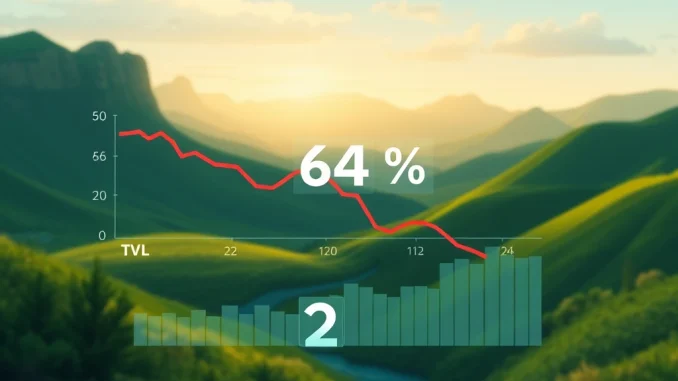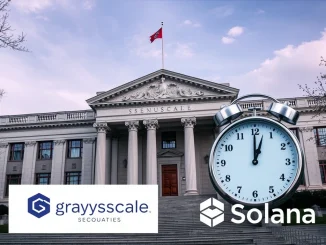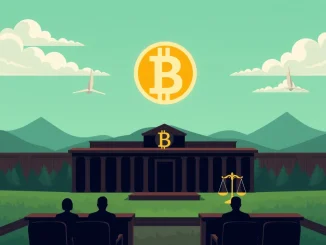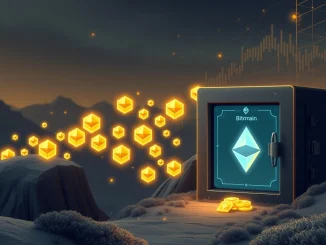
The world of decentralized finance (DeFi) is dynamic, with metrics like Total Value Locked (TVL) constantly fluctuating. Recent data has put the spotlight on Solana, a prominent blockchain network. While the headline figure – a significant drop in Solana DeFi TVL – might seem concerning, the context reveals a more nuanced picture for the network and its position in the crypto landscape. Let’s dive into what the numbers tell us.
What’s Happening with Solana DeFi TVL?
According to data highlighted by Unfolded on X, Solana’s Total Value Locked (TVL) within its decentralized finance ecosystem experienced a substantial decline. Quarter-over-quarter (QoQ), the Solana DeFi TVL fell by 64%, settling at approximately $6.6 billion. This represents a significant decrease in the value of assets locked within Solana’s various DeFi protocols, such as lending platforms, decentralized exchanges (DEXs), and staking services.
Understanding Total Value Locked (TVL) on Solana
Before we delve deeper into the implications of the drop, it’s important to understand what Total Value Locked (TVL) signifies. TVL is a key metric used in DeFi to represent the aggregate value of cryptocurrencies locked within smart contracts of a specific blockchain or protocol. It serves as an indicator of:
- Liquidity: Higher TVL generally means more assets are available for trading, lending, and borrowing within the ecosystem.
- User Adoption and Confidence: An increasing TVL can suggest growing user trust and participation in the network’s DeFi offerings.
- Ecosystem Health: While not the only metric, TVL provides a snapshot of the capital flowing into and being utilized within the DeFi space on a particular chain.
A decrease in TVL, like the one seen on Solana, can result from various factors, including price depreciation of the underlying assets, users withdrawing funds due to market volatility, or shifts in liquidity towards other chains or investment opportunities.
Why Did Solana TVL See a Decline?
Several factors could contribute to a significant drop in Solana TVL over a quarter. While the specific reasons for this 64% decline aren’t detailed in the source data, common drivers for such movements in the broader DeFi TVL market include:
- Market Corrections: If the prices of SOL and other tokens locked within Solana DeFi protocols decrease significantly, the USD value of the TVL will fall, even if the number of tokens locked remains the same.
- Profit-Taking or Risk Aversion: In volatile market conditions, users may withdraw funds from DeFi protocols to realize profits or reduce exposure to potential losses.
- Protocol-Specific Events: Issues or exploits on major DeFi protocols within the Solana ecosystem could lead to rapid fund withdrawals.
- Competition: Liquidity providers might move their assets to DeFi protocols on other blockchain networks offering better yields or perceived lower risks.
Without more context, it’s difficult to pinpoint the exact combination of factors, but a 64% drop suggests a notable shift in market dynamics or user behavior related to Solana DeFi assets.
Solana’s Position: Holding Second in DeFi TVL
Despite the substantial quarterly drop, the data highlights a crucial point: Solana maintains its position as the second-largest network by TVL. This is a significant achievement, especially considering it surpassed TRON in November 2024 to claim this spot. While its TVL figure is now $6.6 billion, its ability to hold the second rank suggests that other major networks may have also experienced declines or that Solana’s ecosystem, despite withdrawals, still retains a significant amount of locked capital compared to its peers (excluding the dominant leader, Ethereum).
Holding the second position in DeFi TVL indicates that:
- Solana’s core DeFi protocols still attract and retain substantial liquidity.
- User and developer activity, while potentially impacted by market conditions, hasn’t completely abandoned the ecosystem.
- Its fundamental architecture and speed continue to be attractive for certain types of DeFi applications and users.
This resilience in ranking, even amidst a TVL contraction, underscores Solana’s established presence and competitiveness in the crowded blockchain space.
The Future of Solana DeFi: Challenges and Opportunities
The drop in Total Value Locked presents challenges for the Solana DeFi ecosystem. A lower TVL can sometimes mean reduced liquidity, potentially impacting trading efficiency and the viability of certain protocols. It might also signal decreased confidence among some users or capital providers.
However, maintaining the second-largest DeFi TVL also presents opportunities. It confirms Solana’s status as a major player, making it an attractive destination for new protocols and developers. The ecosystem can focus on:
- Strengthening existing protocols and building user confidence.
- Innovating with new DeFi primitives that leverage Solana’s unique capabilities.
- Attracting long-term liquidity providers and users who believe in the network’s future growth.
The ability to retain a high ranking despite market headwinds suggests underlying strength and potential for recovery and growth as market conditions improve or as the ecosystem matures further.
Compelling Summary
In summary, while the 64% quarter-over-quarter drop in Solana DeFi TVL to $6.6 billion is a notable contraction, it’s essential to view this data in context. Solana has successfully held onto its position as the second-largest network by Total Value Locked, a rank it achieved by surpassing TRON. This resilience in ranking, despite the decline in locked value, highlights Solana’s significant standing in the decentralized finance landscape. The ecosystem faces the challenge of rebuilding its TVL, likely influenced by broader market trends and protocol-specific developments, but its strong second-place hold underscores its continued importance and potential for future growth in the competitive world of DeFi TVL.



